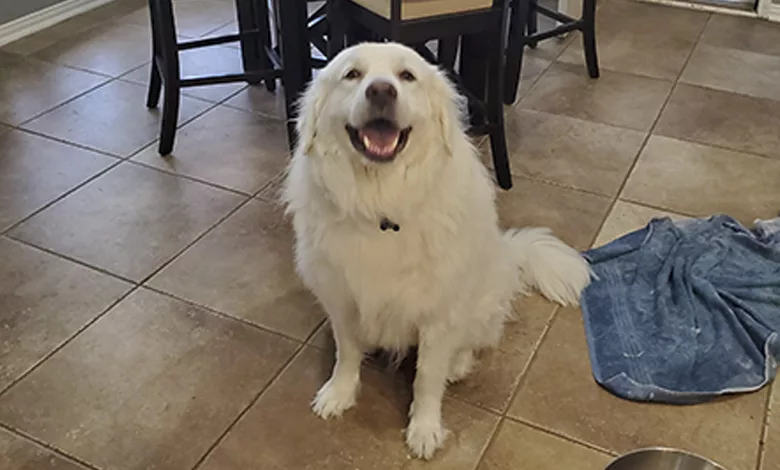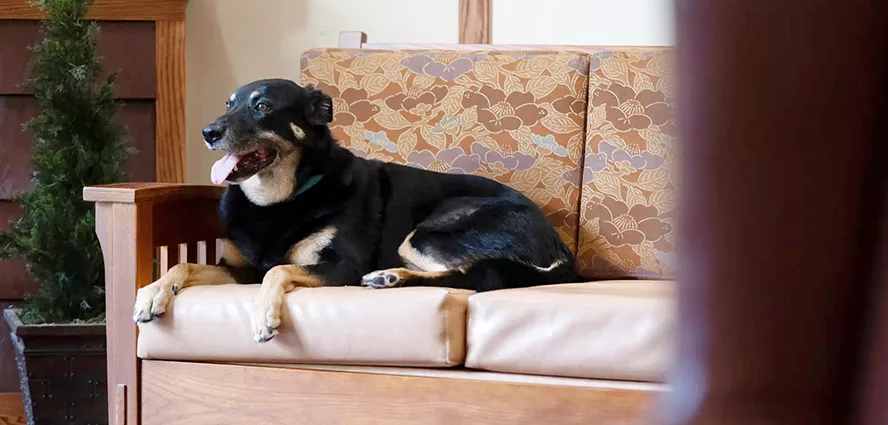
Inside the halls of Sunrise on Hillcrest, Jagger is a big rock star. But unlike his more-famous namesake, he doesn’t sing or strut around on stage.
No, this Jagger searches for scritches and treats from residents of the assisted-living community in Dallas.
And did we mention he is big?
“He’s about 125 pounds,” said Joanne Higgins, the activity and volunteer coordinator for the facility. “He is a gentle giant, once they start petting him, he doesn’t want them to stop, and he sits there and looks at them with his big eyes.”
“Sometimes he’ll give them a little paw, like: ‘Don’t stop itching my ears.’”
Higgins said that the Great Pyrenees moved into the facility about 7 years ago, and he has been a loving presence for residents, including those braving the transition into assisted living.
Some of those residents, she said, are devastated because they are unable to care for a pet anymore.
“Some people move in because of the dog,” Higgins said. “They stay because we give great care, but many people move in because of this dog.”
The bond between Jagger and the residents goes deeper than scritches and treats: Higgins recalls one instance when she was staying overnight at the facility. Jagger woke her up at 2:30 a.m. because a resident had fallen out of bed.
And then there is the story about the resident who would get in trouble for giving him human food.
“When she got to the end of her life … he would go in, and he would just put his face on the side of her bed,” Higgins said.
“When we shut the door, he just laid outside the door waiting for her to pass, like he didn’t want to leave her side.”
Research bears out what many of us have long known: Human interactions with animals can be therapeutic.
A 2019 article published in the journal Anthrozoös found that such interactions can lead to “decreased loneliness and depression, improved cardiovascular health, and increased physical activity” among older adults.
And such benefits don’t require a dog to live on-site. Just a visit from a therapy dog can raise residents’ spirits at an assisted-living facility, said Bud McMahon, a tester observer for the Alliance of Therapy Dogs. The organization comprises about 15,000 certified members who handle over 16,000 dogs.
“There’s a transformation that takes place with these residents,” McMahon said. “Everybody’s looking at this huge dog saying, ‘Boy, that’s a big animal.’ But as soon as they see that the dog is gentle, they start loosening up. It’s incredible.”
“By the time the visit is over, they’re all saying, ‘When are you coming back?’”
It’s fair to say the animal enjoys all the socializing, too. Take the case of Scout, a stray mutt who busted out of captivity at a nearby animal shelter three times one week to visit a facility in Bellaire, Michigan.

Each time he climbed some fences and entered through the automatic doors, and the staff found him sleeping on a lobby couch, said Stephanie Elsey, the Meadow Brook Antrim County Medical Care clinical coordinator.
After that third escape attempt six years ago, the facility’s administrator decided having the pup live on-site was best.
“He knows what residents will give him certain treats,” she said. “He’s pretty particular about his treats but loves all the residents.”
Elsey added that, like Jagger, Scout will stay close to any residents nearing their end. He also has a way of drawing out residents who aren’t very social.
“We had a resident who said that [Scout] makes it feel more like a home than it does like an institution,” she said.
“Especially to people who had dogs in the past, those residents feel like that’s their dog, and that’s just a special thing for them while they’re here that they might not have otherwise gotten.”
Back in Dallas, Higgins said that her experience with dogs like Jagger has convinced her that facilities should have a furry friend living on site, as long as it’s a very trainable breed, like a Great Pyrenees.
“He’s a great, great dog, and he’s so loving,” she said.
As great as he is, though, he avoids some people. “It’s funny. He loves the elderly but is not too keen on the kids,” Higgins said.
“When kids are in the building, he runs and hides.”

